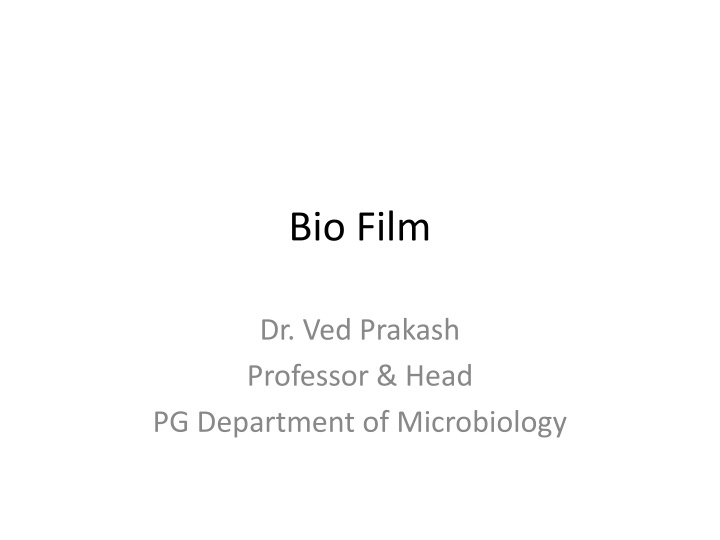
Biofilm Formation: Stages and Implications
Explore the intricate process of biofilm formation, outlining key stages from initial attachment to maturation. Learn how biofilms pose challenges in healthcare settings and environmental systems due to their resilience and potential for pathogenic growth.
Download Presentation

Please find below an Image/Link to download the presentation.
The content on the website is provided AS IS for your information and personal use only. It may not be sold, licensed, or shared on other websites without obtaining consent from the author. If you encounter any issues during the download, it is possible that the publisher has removed the file from their server.
You are allowed to download the files provided on this website for personal or commercial use, subject to the condition that they are used lawfully. All files are the property of their respective owners.
The content on the website is provided AS IS for your information and personal use only. It may not be sold, licensed, or shared on other websites without obtaining consent from the author.
E N D
Presentation Transcript
Bio Film Dr. Ved Prakash Professor & Head PG Department of Microbiology
Biofilm is a living ecosystem made of millions of adherent bacterial cells embedded within a self produced matrix of extracellular polymeric substance i.e. polysaccharide slime layer. Persistent biofilms containing pathogenic bacteria are capable of adherence to damaged tissues (tooth and ear) and plastic surfaces (e.g. medical devices, such as catheters and pacemakers etc.
Steps of biofilm formation Biofilm formation is a complex process that typically involves several stages. Here are the general steps of biofilm formation: Initial Attachment: In this first stage, free-floating microorganisms (planktonic cells) in a liquid environment or on a surface encounter a suitable surface to attach to. This attachment is typically reversible, meaning the microorganisms can detach and reattach.
Irreversible Attachment: After initial attachment, some microorganisms undergo irreversible attachment. They produce adhesive molecules or appendages (such as pili or fimbriae) that firmly anchor them to the surface. Microcolony Formation: As more microorganisms attach to the surface, they start to form small clusters or microcolonies. These microcolonies consist of multiple layers of cells.
Extracellular Matrix Production: Microorganisms within the microcolonies begin to produce and secrete extracellular polymeric substances (EPS), which include polysaccharides, proteins, DNA, and other molecules. These substances form a matrix that surrounds and encases the microorganisms.
Maturation and Biofilm Growth: As the biofilm matures, it becomes more structured and three-dimensional. Microorganisms in the biofilm continue to divide and multiply, contributing to biofilm growth. The extracellular matrix plays a crucial role in providing structural support to the biofilm, helping it adhere to surfaces and resist mechanical forces.
Channel Formation: Within the biofilm, water channels or channels for nutrient flow may form. These channels allow for the transport of nutrients and waste products throughout the biofilm structure.
Quorum Sensing: In many biofilm-forming microorganisms, a communication process called quorum sensing plays a role in coordinating biofilm formation. Microorganisms release signaling molecules, and when a critical concentration of these molecules is reached, it triggers the expression of genes involved in biofilm development.
Maturation and Differentiation: Over time, the biofilm continues to mature and differentiate. Within the biofilm, different microenvironments may exist, resulting in variations in microbial activity, gene expression, and metabolic processes. Detachment: Biofilms are dynamic structures, and microorganisms can detach from the biofilm surface and re-enter the planktonic state. This detachment can be influenced by factors such as environmental conditions, nutrient availability, and physical disturbances.
Dispersal: In some cases, microorganisms in the biofilm can release specialized cells called dispersal cells or swarmer cells. These cells are adapted for motility and can spread to new surfaces to initiate the formation of biofilms elsewhere.
How to control biofilm formation Controlling biofilm formation can be challenging due to the complex and resilient nature of biofilms. However, there are several strategies and approaches that can help mitigate biofilm formation and its associated problems, whether in healthcare settings, industrial processes, or natural environments. Here are some methods for controlling biofilm formation:
Maintain Good Hygiene and Cleaning Practices: In healthcare settings, ensure that medical equipment and surfaces are regularly cleaned and disinfected according to established protocols. In food processing and industrial settings, maintain strict cleaning and sanitation practices to prevent biofilm formation in pipes, tanks, and equipment.
Surface Modification: Alter the surface properties of materials to make them less conducive to biofilm attachment. This can include making surfaces hydrophobic, altering surface charge, or using anti-adhesive coatings. Use materials with inherent resistance to biofilm formation, such as certain types of stainless steel or plastics.
Chemical Disinfection and Antimicrobials: Use appropriate disinfectants and antimicrobial agents to kill or inhibit biofilm-forming microorganisms. However, it's important to note that biofilms can be more resistant to antimicrobial agents than planktonic cells, so higher concentrations or longer exposure times may be needed. Consider the use of biofilm-specific antimicrobial agents or enzymes that target the extracellular matrix.
Biofilm-Disrupting Agents: Develop or use agents that can disrupt mature biofilms. These can include enzymes that break down the extracellular matrix or agents that interfere with quorum sensing, a process by which bacteria communicate and coordinate biofilm formation. Antifouling coatings and materials can help prevent biofilm attachment and growth on surfaces. Mechanical Removal: In some cases, physically removing biofilms may be necessary. This can involve techniques such as scrubbing, jetting, or ultrasonic cleaning. In industrial settings, periodic maintenance and cleaning of equipment can help prevent the build-up of biofilms.
Prevent Nutrient Availability: Biofilm formation often relies on access to nutrients. In industrial processes, controlling nutrient levels in water or other fluids can limit biofilm growth. In healthcare settings, use sterile water and solutions to prevent the introduction of nutrients that could promote biofilm formation.
Biofilm Monitoring: Regularly monitor surfaces and systems for signs of biofilm formation, including visual inspection, microbial testing, and biofilm detection technologies. Education and Training: Ensure that personnel in healthcare and industrial settings are educated and trained in biofilm prevention and control practices. Provide guidelines and protocols for cleaning, disinfection, and maintenance.
Research and Innovation: Continue research into new methods and technologies for biofilm prevention and control, as biofilms can adapt and develop resistance to existing strategies over time.
Quorum sensing Quorum sensing is a mechanism of communication that many bacteria and some other microorganisms use to coordinate their behavior within a population. It allows these microorganisms to sense and respond to changes in their local population density. Quorum sensing relies on the production, release, and detection of specific signaling molecules called autoinducers. When the concentration of autoinducers reaches a threshold level, it triggers coordinated responses in the microbial community.
Here's how quorum sensing works: Production of Autoinducers: Bacteria produce and release small, diffusible molecules called autoinducers into their surrounding environment. The type of autoinducer and its chemical structure can vary among different bacterial species. Accumulation of Autoinducers: As the bacterial population grows and reaches a certain density, the concentration of autoinducers in the environment increases.
Detection of Autoinducers: Bacteria have receptors on their cell membranes or within their cells that can detect the concentration of autoinducers in the environment. When the autoinducer concentration surpasses a certain threshold (indicating a sufficiently large population of bacteria), the receptors are activated. Gene Regulation: Activation of the receptors leads to changes in gene expression within the bacterial cells. This can result in the coordinated regulation of specific genes involved in various processes, depending on the species and context.
Quorum sensing is involved in a wide range of bacterial behaviors and activities, including: Biofilm Formation: Bacteria can use quorum sensing to coordinate the formation of biofilms, which are structured communities of microorganisms attached to surfaces. Biofilms play roles in infections, industrial processes, and environmental systems.
Virulence: Pathogenic bacteria often use quorum sensing to regulate the expression of virulence factors, such as toxins, that are only produced at high population densities. This allows them to mount an effective attack on a host when their numbers are sufficient. Bioluminescence: Some bioluminescent bacteria use quorum sensing to control the production of light. When the population density is high enough, they emit light, as seen in certain species of marine bacteria and fireflies.
Antibiotic Production: Some bacteria produce antibiotics as a defense mechanism against competitors. Quorum sensing can regulate when these antibiotics are produced, ensuring they are deployed when the population is at risk of being overrun by other bacteria.


